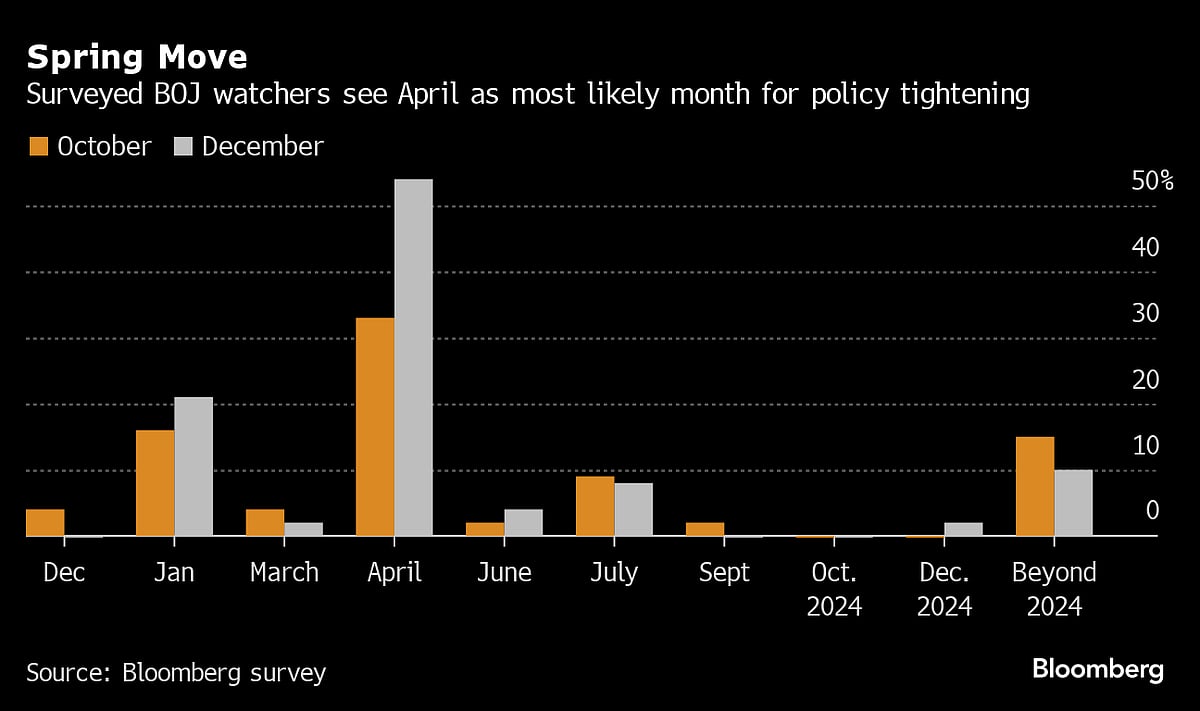BOJ Likely To Keep World’s Last Negative Rate In Upcoming Decision
BOJ officials see little need to rush into scrapping the negative rate this month.

(Bloomberg) -- The Bank of Japan is widely expected to keep the world’s last negative interest rate intact on Tuesday, with investors set to scour comments for hints on if — and when — authorities might scrap the policy next year.
Almost all 52 economists surveyed by Bloomberg forecast no change in major policy settings for the short-term rate and yield curve control mechanism at the policy meeting that concludes on Dec. 19.

With two-thirds forecasting an end to the subzero rate by April, economists’ key focus will be whether the bank signals any progress toward achieving its inflation goal. Following the Federal Reserve’s surprise dovish turn last week, market watchers will be on guard against another potential surprise by Governor Kazuo Ueda.
BOJ officials see little need to rush into scrapping the negative rate this month in the absence of enough evidence of wage growth to support sustainable inflation, people familiar with the matter told Bloomberg earlier this month.
Meantime, the yield curve control policy isn’t under the spotlight, as it’s widely seen to have become an insurance policy to prevent a sudden surge of bond yields ever since Ueda enhanced the mechanism’s flexibility in October.
This week’s meeting doesn’t coincide with the release of updated forecasts in a quarterly outlook report. That leaves the BOJ with two channels in which to convey its latest thinking: the policy statement, which usually comes around noon, and Ueda’s post-meeting press conference at 3:30 p.m.
A series of events earlier this month reignited speculation of a potential early rate move. Deputy Governor Ryozo Himino’s generally upbeat discussion of what the impact of a hike might be was the first. Ueda further fueled the rumblings by musing that his job would become “more challenging” from the year-end. He said that before meeting with Prime Minister Fumio Kishida, who has highlighted the importance of policy alignment.
What Bloomberg Economics Says...
“Some investors saw recent comments by Bank of Japan officials, broaching the topic of exit scenarios, as a signal of an imminent move away from yield curve control. This is likely a mistake. We see the messaging as part of a long process of laying the groundwork for a smooth transition next year, most likely in July.”
Taro Kimura, economist
Click here to read the full report.
For Kishida, one aspect of policy alignment means supporting the yen in order to cap imported inflation. His support ratings have sagged due to simmering resentment over rising costs of living.
Kishida and his party are at the center of one new factor expected to encourage the BOJ to hold: last week’s political turmoil. Four cabinet ministers in Kishida’s administration were forced to resign Thursday after a funding scandal enveloped the biggest faction in the ruling Liberal Democratic Party. The administration’s low approval ratings took yet another hit, tumbling to the lowest for a Japanese cabinet in 14 years.
If he’s going to conduct the nation’s first rate hike since 2007, Ueda probably would prefer to do so when the government is stable and in a position to coordinate. In the past, exits from ultraeasy policy were derided as premature. In one case, the central bank carried out a policy reversal that ultimately proved a failure in the face of government objections.
Around one-third of BOJ watchers expect the bank to drop a hint Tuesday laying the groundwork for normalization in coming months, while about half don’t foresee that happening.
The BOJ has so far refrained from giving any clear hints of the timing of a potential liftoff. That suggests Japanese authorities aren’t likely to resort to the sort of clear-cut messaging employed by the Fed and some of its peers, when officials sometimes telegraphed further rate hikes at the peak of their fights against inflation.
In October, Ueda suggested at a post-meeting press conference that the bank was getting slightly closer to reducing monetary stimulus by saying the certainty for hitting its inflation target had risen a little. Subtle tweaks to its macroeconomic assessments may continue to be the extent to which the bank communicates its intentions.
There is no need for the BOJ to give additional guidance for raising rates as market players are already broadly and rightly expecting it to happen in April, according to Hideo Hayakawa, a former BOJ executive director.
Other key factors to watch:
- Whether Ueda will change his assessment over the likelihood of attaining the bank’s inflation target is a critical point. If the governor upgrades this view, it could trigger a visible impact across financial markets.
- Ueda’s views over next year’s wage growth prospects are another important point. Momentum seems to be building. Some businesses have already announced ambitious pay plans, and unions have made demands that appear to reflect confidence. If the governor signals growing optimism, it means the bank is coming closer to declaring victory.
- BOJ watchers will be assessing Ueda’s view on the potential impact from the Fed’s pivot, as some see it narrowing room for a BOJ hike by raising the risk of a stronger yen. With uncertainties over the path of the US economy, Ueda will likely pledge to monitor the situation closely.
- The BOJ may choose to change its assessment of consumer spending in its statement after it contributed to the deepest economic contraction since the pandemic last quarter. That would be a sign of cautiousness, reminding investors that not all is rosy.
- Any change in forward guidance would be a surprise to most surveyed economists, as only two predict it will happen. The BOJ has consistently vowed to add monetary easing if necessary, indicating its readiness to respond if downside risks emerge.
More stories like this are available on bloomberg.com
©2023 Bloomberg L.P.